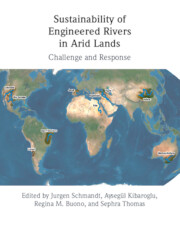Book contents
- Sustainability of Engineered Rivers in Arid Lands
- Sustainability of Engineered Rivers in Arid Lands
- Copyright page
- Dedication
- Contents
- Contributors
- Part I Introduction
- Part II Challenge
- Part III Engineered Rivers
- Part IV Response
- 16 River Basin Management and Irrigation
- 17 “Intelligent” Water Transfers
- 18 Better Basin Management with Stakeholder Participation
- Part V Conclusion
- Index
- References
16 - River Basin Management and Irrigation
from Part IV - Response
Published online by Cambridge University Press: 16 September 2021
- Sustainability of Engineered Rivers in Arid Lands
- Sustainability of Engineered Rivers in Arid Lands
- Copyright page
- Dedication
- Contents
- Contributors
- Part I Introduction
- Part II Challenge
- Part III Engineered Rivers
- Part IV Response
- 16 River Basin Management and Irrigation
- 17 “Intelligent” Water Transfers
- 18 Better Basin Management with Stakeholder Participation
- Part V Conclusion
- Index
- References
Summary
This chapter discusses both the role of irrigation in river basin development and closure and how its share in total water use can be reduced. It first briefly outlines the importance of unchecked irrigation development in the growing share of water consumption and the closure process of the basins examined in this volume. This understanding of how irrigation came to play a peculiar role in river basin development is important for discussing how its share can be reduced. The chapter recalls the diversity of policy options available to respond to imbalances between supply and demand and that supply augmentation is generally favored. Finally, the chapter focuses on the issue of "water savings," documenting various responses by the irrigated sector to shortages and exploring how policies to modernize irrigation technologies may inadvertently contribute to enhancing evapotranspiration and therefore undermine purported conservation objectives.
Keywords
- Type
- Chapter
- Information
- Sustainability of Engineered Rivers In Arid LandsChallenge and Response, pp. 235 - 245Publisher: Cambridge University PressPrint publication year: 2021

